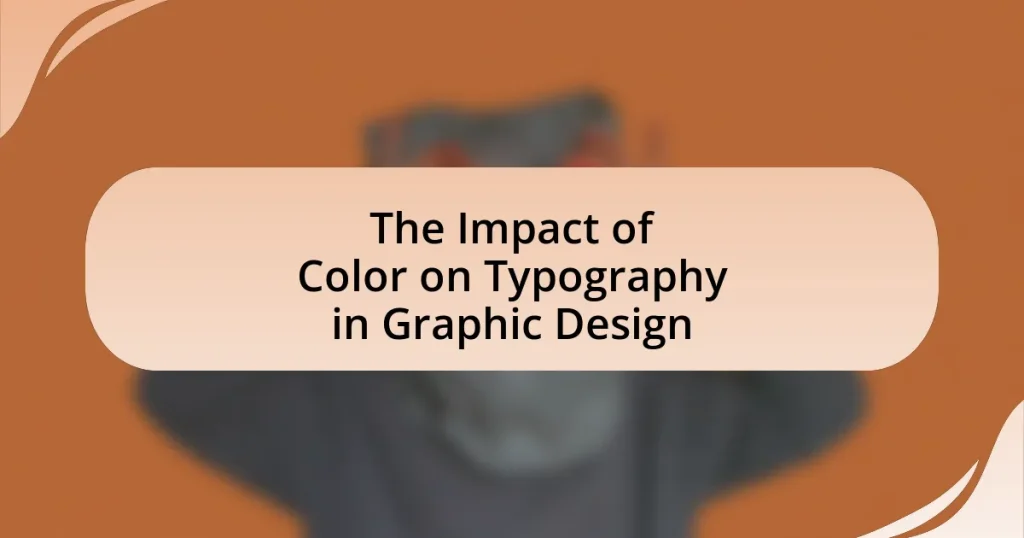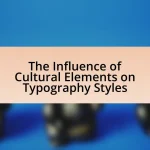The article examines the significant impact of color on typography within graphic design, highlighting its influence on readability, emotional response, and brand identity. It discusses how color contrast affects legibility, with high contrast improving readability and low contrast hindering it. The article also explores the psychological effects of different colors on readers, the importance of color selection for effective communication, and the role of color harmony in enhancing visual appeal. Additionally, it addresses best practices for ensuring color accessibility and strategies for optimizing color use in typography to enhance user experience and engagement.
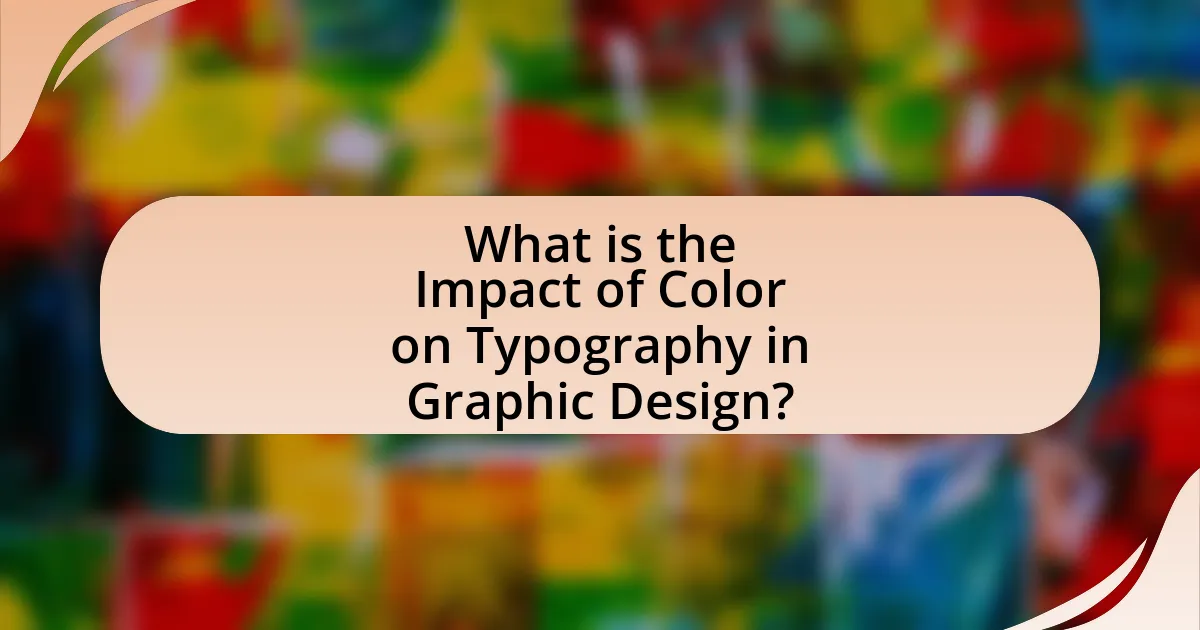
What is the Impact of Color on Typography in Graphic Design?
Color significantly impacts typography in graphic design by influencing readability, emotional response, and brand identity. The choice of color can enhance or hinder the legibility of text; for instance, high contrast between text and background colors improves readability, while low contrast can make text difficult to read. Research indicates that color can evoke specific emotions; for example, blue often conveys trust, while red can evoke urgency. Additionally, color plays a crucial role in establishing brand identity; consistent use of specific colors in typography helps reinforce brand recognition. According to a study by the Institute for Color Research, people make a subconscious judgment about a person, environment, or product within 90 seconds of initial viewing, with color being a primary factor in that judgment. Thus, the strategic use of color in typography is essential for effective communication in graphic design.
How does color influence the perception of typography?
Color significantly influences the perception of typography by affecting readability, emotional response, and brand recognition. For instance, high-contrast color combinations, such as black text on a white background, enhance legibility, while softer colors may create a more inviting or calming effect. Research indicates that colors evoke specific emotions; for example, blue often conveys trust and professionalism, while red can evoke urgency or excitement. Additionally, consistent color usage in typography strengthens brand identity, as seen in studies where consumers associate specific colors with particular brands, enhancing recall and recognition. Thus, the strategic application of color in typography is essential for effective communication in graphic design.
What psychological effects do different colors have on readers?
Different colors evoke specific psychological effects on readers, influencing their emotions and perceptions. For instance, blue often promotes feelings of calmness and trust, making it effective for corporate branding, while red can evoke excitement or urgency, commonly used in sales promotions. Yellow is associated with optimism and creativity, which can enhance engagement, whereas green typically signifies tranquility and health, often utilized in eco-friendly branding. Research by the Institute for Color Research indicates that color can increase brand recognition by up to 80%, demonstrating the significant impact colors have on reader responses and decision-making processes.
How does color contrast affect readability and legibility?
Color contrast significantly affects readability and legibility by influencing how easily text can be distinguished from its background. High contrast, such as black text on a white background, enhances legibility, making it easier for readers to process information quickly. Conversely, low contrast, like light gray text on a white background, can lead to eye strain and difficulty in reading, particularly for individuals with visual impairments. Research by the World Wide Web Consortium (W3C) indicates that a contrast ratio of at least 4.5:1 is recommended for normal text to ensure adequate readability. This evidence underscores the importance of color contrast in graphic design, as it directly impacts user experience and accessibility.
Why is color selection important in typography?
Color selection is important in typography because it significantly affects readability, emotional response, and brand identity. Readability is enhanced when there is sufficient contrast between text color and background color, making it easier for the audience to engage with the content. Emotional response is influenced by color psychology; for example, blue often conveys trust, while red can evoke urgency. Furthermore, consistent color choices reinforce brand identity, as specific colors can become synonymous with a brand, aiding in recognition and recall. Studies show that color can increase comprehension by up to 73%, highlighting its critical role in effective communication through typography.
What role does color play in brand identity through typography?
Color plays a crucial role in brand identity through typography by influencing perception and emotional response. The choice of color in typography can evoke specific feelings and associations, which helps to communicate the brand’s values and personality. For instance, blue often conveys trust and professionalism, making it popular among financial institutions, while red can evoke excitement and urgency, frequently used in food and entertainment sectors. Research indicates that color can increase brand recognition by up to 80%, highlighting its significance in establishing a strong brand identity.
How can color enhance or detract from the message of the text?
Color can enhance or detract from the message of the text by influencing emotional responses and readability. For instance, warm colors like red and orange can evoke excitement or urgency, while cool colors like blue and green can convey calmness or trust. Research indicates that color can affect comprehension; a study published in the journal “Color Research and Application” found that text in high-contrast colors is easier to read and retains attention better than low-contrast combinations. Therefore, the choice of color directly impacts how effectively the message is communicated and perceived by the audience.
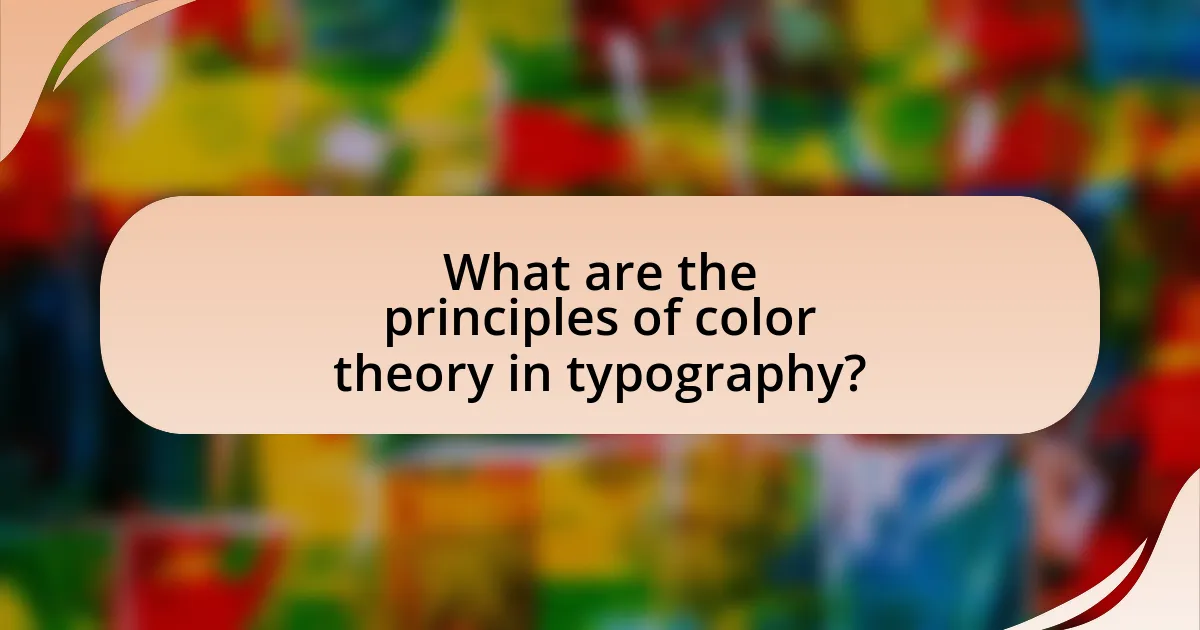
What are the principles of color theory in typography?
The principles of color theory in typography include contrast, harmony, and meaning. Contrast ensures readability by using colors that stand out against each other, such as dark text on a light background. Harmony involves selecting colors that complement each other, creating a cohesive visual experience; for example, analogous colors can enhance the aesthetic appeal of text. Meaning refers to the psychological impact of colors, where different hues evoke specific emotions or associations, such as blue conveying trust and red indicating urgency. These principles guide designers in making informed choices that enhance communication and visual effectiveness in typography.
How do complementary colors affect typographic design?
Complementary colors significantly enhance typographic design by creating visual contrast that improves readability and draws attention. When used effectively, these colors can make text stand out against backgrounds, ensuring that the message is clear and engaging. For instance, pairing blue text with an orange background utilizes the complementary relationship between these colors, which can lead to a more dynamic and appealing design. Research indicates that high contrast between complementary colors can increase legibility by up to 40%, making it easier for viewers to process information quickly. This principle is widely applied in branding and advertising to capture audience interest and convey messages effectively.
What are examples of effective complementary color pairings in typography?
Effective complementary color pairings in typography include blue and orange, red and green, and purple and yellow. These combinations create visual contrast that enhances readability and draws attention. For instance, blue text on an orange background is often used in advertising to capture interest, while red and green are commonly seen in holiday-themed designs, ensuring that the text stands out. Purple and yellow, frequently utilized in creative industries, provide a vibrant contrast that can energize a design. These pairings leverage the principles of color theory, where complementary colors are opposite each other on the color wheel, maximizing visual impact and engagement.
How can designers use analogous colors to create harmony in typography?
Designers can use analogous colors to create harmony in typography by selecting colors that are adjacent to each other on the color wheel, which fosters a cohesive visual experience. This approach allows for a smooth transition between hues, enhancing readability and aesthetic appeal. For instance, using shades of blue and green together can evoke a calming effect, making the text more inviting and easier to read. Research in color theory supports that analogous color schemes can reduce visual tension and create a sense of unity, which is essential in effective graphic design.
What is the significance of color harmony in typography?
Color harmony in typography is significant because it enhances readability and aesthetic appeal, creating a cohesive visual experience. When colors are harmonized, they work together to guide the viewer’s eye and convey the intended message effectively. Research indicates that harmonious color combinations can improve user engagement and retention of information, as seen in studies on color psychology and design principles. For instance, a study published in the Journal of Experimental Psychology found that well-coordinated colors can lead to higher levels of comprehension and satisfaction among readers. Thus, color harmony is essential in typography for effective communication and visual impact.
How does color harmony contribute to visual appeal in graphic design?
Color harmony significantly enhances visual appeal in graphic design by creating a balanced and aesthetically pleasing composition. When colors are harmoniously combined, they evoke emotions and guide the viewer’s attention, making the design more engaging. Research indicates that harmonious color schemes can improve user experience and retention; for instance, a study published in the Journal of Vision found that color harmony influences the perception of beauty and can lead to increased viewer satisfaction. Thus, effective use of color harmony not only attracts attention but also fosters a positive emotional response, reinforcing the overall impact of graphic design.
What techniques can be used to achieve color harmony in typography?
To achieve color harmony in typography, designers can utilize techniques such as complementary color schemes, analogous color schemes, and the use of color contrast. Complementary color schemes involve pairing colors that are opposite each other on the color wheel, creating a vibrant look that enhances readability. Analogous color schemes consist of colors that are next to each other on the color wheel, providing a more subtle and cohesive appearance. Additionally, employing color contrast, such as light text on a dark background or vice versa, can significantly improve legibility and visual interest. These techniques are supported by color theory principles, which emphasize the psychological effects of color combinations on viewer perception and engagement.
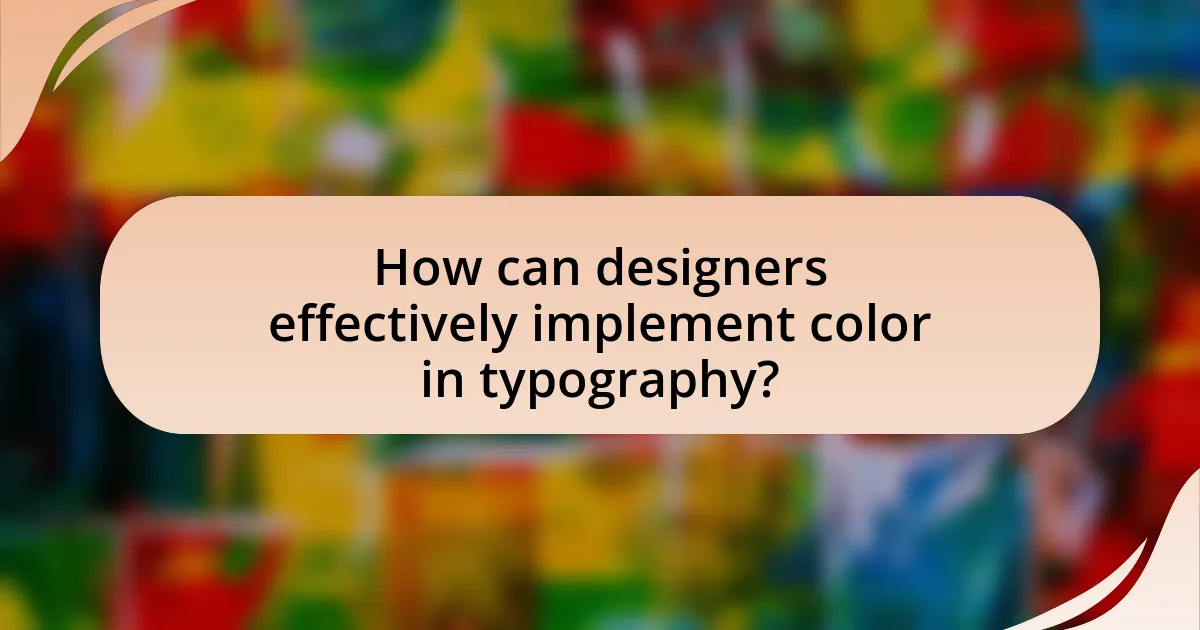
How can designers effectively implement color in typography?
Designers can effectively implement color in typography by using color contrast to enhance readability and convey meaning. High contrast between text and background colors improves legibility, as evidenced by studies showing that black text on a white background is the most readable combination. Additionally, color can evoke emotions and associations; for instance, blue often conveys trust, while red can signify urgency. Research from the Institute for Color Research indicates that color can increase brand recognition by up to 80%, demonstrating its importance in design. By strategically selecting colors that align with the message and context, designers can create impactful typographic compositions.
What tools and resources are available for color selection in typography?
Color selection in typography can be effectively managed using tools such as Adobe Color, Coolors, and Paletton. Adobe Color allows users to create color schemes based on color theory principles, while Coolors offers a user-friendly interface for generating color palettes quickly. Paletton enables designers to visualize color combinations in real-time, ensuring harmony in typography. These tools are widely recognized in the graphic design community for their ability to enhance visual communication through effective color choices.
How can color palettes enhance typographic choices?
Color palettes enhance typographic choices by creating visual harmony and improving readability. When a color palette is thoughtfully selected, it can complement the typeface, making the text more engaging and easier to read. For instance, contrasting colors can highlight important information, while analogous colors can create a cohesive look that draws the reader’s attention. Research indicates that color can influence perception and emotional response; for example, a study published in the journal “Color Research and Application” found that color combinations can significantly affect how people interpret text, enhancing the overall communication of the message.
What software can assist in color and typography integration?
Adobe Creative Suite, particularly Adobe Illustrator and Adobe InDesign, can assist in color and typography integration. These software programs offer extensive tools for managing color palettes and typography styles, allowing designers to create cohesive visual identities. For instance, Adobe Illustrator provides features like the Color Guide and the ability to create custom color swatches, while Adobe InDesign allows for precise typography control with styles and formatting options. Both programs are widely used in the graphic design industry, making them reliable choices for effective color and typography integration.
What are common mistakes to avoid when using color in typography?
Common mistakes to avoid when using color in typography include poor contrast, overusing colors, and neglecting color psychology. Poor contrast between text and background can lead to readability issues; for instance, light gray text on a white background is difficult to read. Overusing multiple colors can create visual clutter, making it hard for the audience to focus on the message. Additionally, neglecting color psychology can result in miscommunication; for example, using red can evoke urgency or danger, which may not align with the intended message. These mistakes can significantly diminish the effectiveness of typography in graphic design.
How can poor color choices impact user experience?
Poor color choices can significantly detract from user experience by impairing readability and creating visual discomfort. When text color does not contrast adequately with the background, it can lead to difficulty in reading, which may frustrate users and cause them to abandon the content. Research indicates that poor contrast can reduce legibility by up to 50%, making it harder for users to engage with the material. Additionally, colors that clash or are overly bright can induce eye strain, further diminishing the overall user experience. Therefore, effective color selection is crucial in graphic design to ensure clarity and maintain user engagement.
What are the consequences of neglecting accessibility in color usage?
Neglecting accessibility in color usage leads to significant barriers for individuals with visual impairments, resulting in exclusion from information and services. Approximately 1 in 12 men and 1 in 200 women are affected by color blindness, which means that poor color contrast can render text illegible for a substantial portion of the population. Furthermore, inaccessible color choices can violate legal standards, such as the Americans with Disabilities Act (ADA), exposing organizations to potential lawsuits and reputational damage. Inadequate color accessibility also diminishes user experience, as individuals may struggle to navigate content, leading to frustration and disengagement.
What best practices should designers follow for color in typography?
Designers should prioritize contrast, readability, and color harmony when selecting colors for typography. High contrast between text and background enhances legibility, ensuring that the content is easily readable. For instance, using dark text on a light background or vice versa is a common practice that improves visibility. Additionally, designers should consider the psychological effects of colors, as different hues can evoke specific emotions and associations. For example, blue often conveys trust, while red can signify urgency. Furthermore, maintaining a cohesive color palette that aligns with the brand identity fosters a unified visual experience. Research indicates that color can influence user engagement and comprehension, emphasizing the importance of thoughtful color choices in typography.
How can designers ensure color accessibility for all users?
Designers can ensure color accessibility for all users by adhering to established color contrast guidelines, such as the Web Content Accessibility Guidelines (WCAG), which recommend a contrast ratio of at least 4.5:1 for normal text and 3:1 for large text. This ensures that text is legible for individuals with visual impairments, including color blindness. Additionally, designers should utilize color-blind friendly palettes and avoid relying solely on color to convey information, incorporating text labels or patterns as supplementary cues. Research indicates that approximately 1 in 12 men and 1 in 200 women have some form of color vision deficiency, highlighting the importance of these practices in reaching a broader audience.
What strategies can enhance the effectiveness of color in typography?
To enhance the effectiveness of color in typography, designers should utilize color contrast, establish a clear hierarchy, and consider color psychology. Color contrast ensures that text is legible against its background, which is crucial for readability; for example, using dark text on a light background or vice versa can significantly improve visibility. Establishing a clear hierarchy through varying color weights and shades helps guide the reader’s attention, making important information stand out. Additionally, understanding color psychology allows designers to evoke specific emotions and responses; for instance, blue often conveys trust, while red can evoke urgency. These strategies collectively improve the communication of messages through typography.
